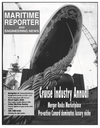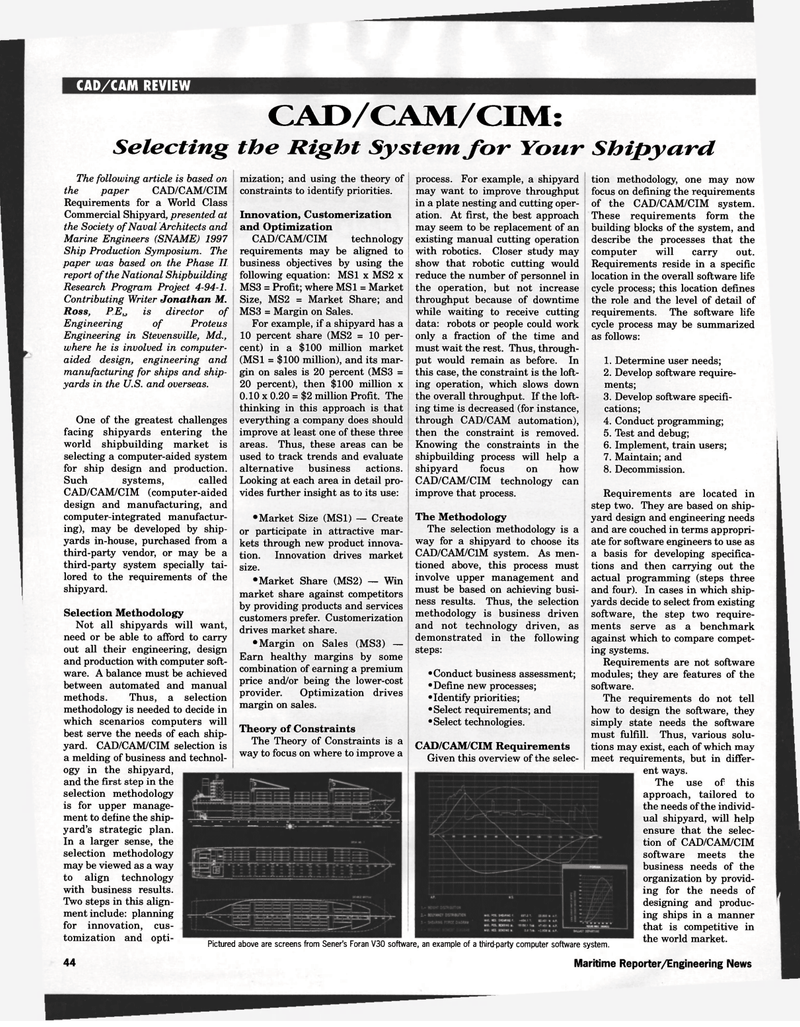
Page 44: of Maritime Reporter Magazine (July 1997)
Read this page in Pdf, Flash or Html5 edition of July 1997 Maritime Reporter Magazine
CAD/CAM REVIEW
CAD/CAM/CIM:
Selecting the Right System /or Fowr Shipyard
The following article is based on the paper CAD/CAM/CIM
Requirements for a World Class
Commercial Shipyard, presented at the Society of Naval Architects and
Marine Engineers (SNAME) 1997
Ship Production Symposium. The paper was based on the Phase II report of the National Shipbuilding
Research Program Project 4-94-1.
Contributing Writer Jonathan M.
Ross, P.E._, is director of
Engineering of Proteus
Engineering in Stevensville, Md., where he is involved in computer- aided design, engineering and manufacturing for ships and ship- yards in the U.S. and overseas.
One of the greatest challenges facing shipyards entering the world shipbuilding market is selecting a computer-aided system for ship design and production.
Such systems, called
CAD/CAM/CIM (computer-aided design and manufacturing, and computer-integrated manufactur- ing), may be developed by ship- yards in-house, purchased from a third-party vendor, or may be a third-party system specially tai- lored to the requirements of the shipyard.
Selection Methodology
Not all shipyards will want, need or be able to afford to carry out all their engineering, design and production with computer soft- ware. A balance must be achieved between automated and manual methods. Thus, a selection methodology is needed to decide in which scenarios computers will best serve the needs of each ship- yard. CAD/CAM/CIM selection is a melding of business and technol- ogy in the shipyard, and the first step in the selection methodology is for upper manage- ment to define the ship- yard's strategic plan.
In a larger sense, the selection methodology may be viewed as a way to align technology with business results.
Two steps in this align- ment include: planning for innovation, cus- tomization and opti- mization; and using the theory of constraints to identify priorities.
Innovation, Customerization and Optimization
CAD/CAM/CIM technology requirements may be aligned to business objectives by using the following equation: MSI x MS2 x
MS3 = Profit; where MSI = Market
Size, MS2 = Market Share; and
MS3 = Margin on Sales.
For example, if a shipyard has a 10 percent share (MS2 = 10 per- cent) in a $100 million market (MSI = $100 million), and its mar- gin on sales is 20 percent (MS3 = 20 percent), then $100 million x 0.10 x 0.20 = $2 million Profit. The thinking in this approach is that everything a company does should improve at least one of these three areas. Thus, these areas can be used to track trends and evaluate alternative business actions.
Looking at each area in detail pro- vides further insight as to its use: •Market Size (MSI) — Create or participate in attractive mar- kets through new product innova- tion. Innovation drives market size. •Market Share (MS2) — Win market share against competitors by providing products and services customers prefer. Customerization drives market share. •Margin on Sales (MS3) —
Earn healthy margins by some combination of earning a premium price and/or being the lower-cost provider. Optimization drives margin on sales.
Theory of Constraints
The Theory of Constraints is a way to focus on where to improve a process. For example, a shipyard may want to improve throughput in a plate nesting and cutting oper- ation. At first, the best approach may seem to be replacement of an existing manual cutting operation with robotics. Closer study may show that robotic cutting would reduce the number of personnel in the operation, but not increase throughput because of downtime while waiting to receive cutting data: robots or people could work only a fraction of the time and must wait the rest. Thus, through- put would remain as before. In this case, the constraint is the loft- ing operation, which slows down the overall throughput. If the loft- ing time is decreased (for instance, through CAD/CAM automation), then the constraint is removed.
Knowing the constraints in the shipbuilding process will help a shipyard focus on how
CAD/CAM/CIM technology can improve that process.
The Methodology
The selection methodology is a way for a shipyard to choose its
CAD/CAM/CIM system. As men- tioned above, this process must involve upper management and must be based on achieving busi- ness results. Thus, the selection methodology is business driven and not technology driven, as demonstrated in the following steps: •Conduct business assessment; •Define new processes; •Identify priorities; •Select requirements; and • Select technologies.
CAD/CAM/CIM Requirements
Given this overview of the selec-
Pictured above are screens from Sener's Foran V30 software, an example of a third-party computer software system. tion methodology, one may now focus on defining the requirements of the CAD/CAM/CIM system.
These requirements form the building blocks of the system, and describe the processes that the computer will carry out.
Requirements reside in a specific location in the overall software life cycle process; this location defines the role and the level of detail of requirements. The software life cycle process may be summarized as follows: 1. Determine user needs; 2. Develop software require- ments; 3. Develop software specifi- cations; 4. Conduct programming; 5. Test and debug; 6. Implement, train users; 7. Maintain; and 8. Decommission.
Requirements are located in step two. They are based on ship- yard design and engineering needs and are couched in terms appropri- ate for software engineers to use as a basis for developing specifica- tions and then carrying out the actual programming (steps three and four). In cases in which ship- yards decide to select from existing software, the step two require- ments serve as a benchmark against which to compare compet- ing systems.
Requirements are not software modules; they are features of the software.
The requirements do not tell how to design the software, they simply state needs the software must fulfill. Thus, various solu- tions may exist, each of which may meet requirements, but in differ- ent ways.
The use of this approach, tailored to the needs of the individ- ual shipyard, will help ensure that the selec- tion of CAD/CAM/CIM software meets the business needs of the organization by provid- ing for the needs of designing and produc- ing ships in a manner that is competitive in the world market. 44 Maritime Reporter/Engineering News

 43
43

 45
45
